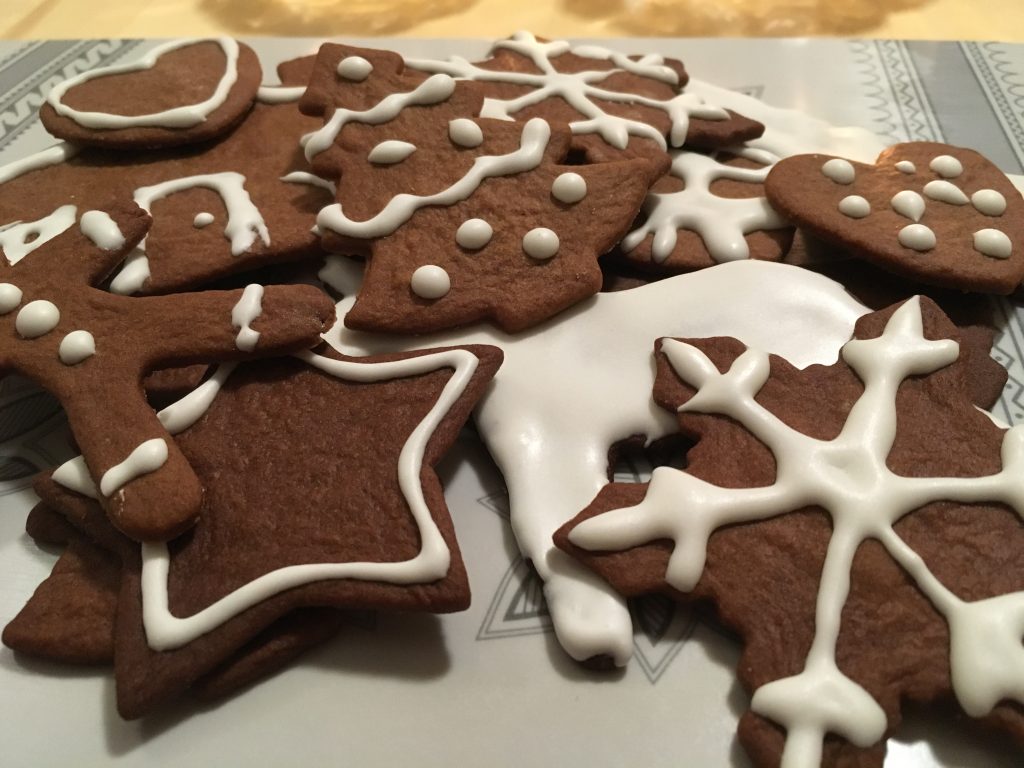Bake your own Swedish pepparkakor! Posted by Chelsea B on Dec 18, 2019 in Culture
Each Christmas, I make a few Swedish recipes to share with family and friends. My two favorites are glögg, wine mulled in spices, and pepparkakor, crispy, spicy ginger cookies. While these recipes are old classics, I love them because they are also staples for modern Swedish holiday celebrations.
Many Swedish-American food traditions are recipes that have been passed down through generations after the first Swedes immigrated here back in the late 1800’s and early 1900’s. For example, potatiskorv (potato sausage) makes an appearance on the Swedish-American julbord (Swedish Christmas table). Originally made to save money by cutting the meat mixture with potato, this humble korv is a thing of the past in Sweden.
A fantastic example of a dish that is both traditional, yet still very common in Sweden is Swedish meatballs. Best matched with potatoes and lingonberries, Swedish-Americans love ‘em too. Around the holidays, you’ll find long lines at Ingebretsen’s Nordic Marketplace in Minneapolis, Minnesota, where folks go nuts to buy both their house-made potatiskorv and special meatball mix, among other items, like sill (herring), blood pudding, head cheese, and other quirky, yet lovable Scandinavian delights.
Now, back to MY favorites, glögg and pepparkakor. These beloved holiday menu items are unavoidable in Sweden. Glögg is made by steeping red wine with warming spices like kanel, kardemumma, ingefära, och nejlikor (cinnamon, cardamom, ginger, and cloves). Sugar is added, perhaps some brightness with orange, and finally, more alcohol! When I make glögg, I typically follow chef Marcus Samuelsson’s recipe here for red wine glögg and here for white wine glögg. My advice, don’t skimp on the spices, get them fresh if you can!
For a non-alcoholic version of this drink substitute red wine for black currant juice, or white wine for apple juice. Cut down the sugar in the recipe and you’ll be good to go!
To make basic pepparkakor, use the recipe below by Swedish supermarket ICA. A couple of Chelsea’s pro tips – first, add a dash more of each spice listed, to ensure a nice zip to your cookies. Second, use plenty of flour to roll out your dough as thinly as possible for extra crisp!
Okej, är ni redo?! Okay, are you ready?! The recipe in listed first in Swedish, next in English!
PORTIONER: cirka 125 stycken
Ingredienser
- 2 ½ deciliter brun farin
- ¾ deciliterljus sirap
- ¾ deciliter vatten
- 150 gram smör eller margarin
- 1 matsked malen kanel
- 1 matsked malen ingefära
- 1 tesked malna kryddnejlikor
- cirka 6 deciliter vetemjöl (+ extra till utbakning)
- 1 ½ tesked bikarbonat
Gör så här
Blanda farinsockret, sirapen och vattnet i en kastrull. Koka upp blandningen.
Lägg i matfettet och låt det smälta. Tillsätt kryddorna.
Låt massan kallna utan omrörning.
Rör i bikarbonaten och mjölet.
Linda in degen i plastfolie. Låt den stå kallt till nästa dag.
Sätt ugnen på 175°C.
Arbeta degen smidig på mjölat bord. Baka en provkaka för att se om degen håller måttet, om kakan flyter så arbeta in lite mer mjöl i degen.
Kavla ut degen tunt och ta ut kakor med mått. Lägg dem på smord plåt eller på bakplåtspapper. Grädda kakorna mitt i ugnen i 175°C, 6-8 min.
Låt kakorna svalna på plåten. Förvaras i burk i rumstemperatur eller i frys.
Swedish Ginger Cookies
Portion size around 125 cookies
Ingredients
- 1 cup and one tablespoon brown sugar
- ⅓ cup light corn syrup
- ⅓ cup water
- 150 grams, approx. 1 and ½ sticks of butter
- 1 tablespoon of ground cinnamon
- 1 tablespoon of ground ginger
- 1 teaspoon of ground cloves
- Approx. 2 ½ cups flour (+ extra for rolling out the dough)
- 1 ½ teaspoon baking soda
Instructions
In a saucepan, mix the brown sugar, syrup and water. Simmer the mixture.
Add the butter (or margarine) and let it melt. Add the spices.
Allow the mixture to cool without stirring.
Stir in the baking soda and flour.
Wrap the dough in plastic wrap. Let it chill in the fridge until the next day.
Set oven to 350 F.
Work dough smoothly on a floured surface. Bake a test cookie to see if the dough is moderate, if the dough sticks then work in a little more flour in the dough.
Roll out the dough thinly and cut cookies with cookie cutters. Add them to a greased sheet or use parchment paper. Bake the cookies in the middle oven rack for 6-8 minutes.
Let the cookies cool. Can be stored at room temperature and the dough can be kept in the fridge or in the freezer.
That’s it! Want to decorate your cookies? I use this royal icing recipe. Happy baking!

Build vocabulary, practice pronunciation, and more with Transparent Language Online. Available anytime, anywhere, on any device.






